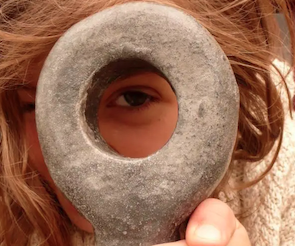Prior to this module, the thought of Pure Data, and any kind coding in general, vastly intimidated me and I wasn’t particularly attracted to the idea of working with it. However since learning and understanding the basics of Pure Data, and the Bela board, I have a new found enthusiasm and desire to continue to learn the foundations of Pure Data. I want to expand my knowledge and work creatively, involving PD and the circuitry that accompanies it. I feel this is a really interesting opportunity to incorporate both my sound work with my film and physical art work.

DIGITAL INPUT
( Drum Synthesis. )


The images above demonstrate how to work with the digital inputs of Bela from Pure Data, using a button and an LED to create a simple drum machine.
To understand the mechanics of the button; there are two pieces of metal that are connected to each of the legs on the button. When the button is not pressed, the metal contacts aren’t touching each other and so the circuit is open. However, when the button is pressed the two pieces of metal make contact with one another, therefore completing the circuit and allowing the electricity to flow. In this case the button controls both the LED light turning on and off, as well as a sound occurring each time.
Above, in the left hand screenshot of code, you can see the Snare and Kick abstractions (abstractions are sub-patches that are saved as separate .pd files, to be continually used in other patches). When you press down on the button you hear the kick sound, and as you take your finger off it, the snare sound occurs.
In the picture on the right hand side is the code for playing different frequency tones from the same button, using the [osc~] object to generate a sine tone. By using the [sel 0 1 2 3 ] I was able to create sounds for each press, which triggered different frequency values every 4 counts. Hear below ….
As I became more confident with this code, I began adding more buttons, allocating different sounds to each button, some making the kick and snare sound and others playing different frequency tones. This allowed for multiple sounds to be played at once, creating a kind of drum machine, which was fun to play around with.
I found these opening tasks to Pure data and the Bela board very exciting and incredibly interesting to learn and work with as it is an entirely new concept that I have never experimented with before. As I have previously said, I had to no prior knowledge or interest in working with Pure data, however since completing these tasks, although very basic, I feel inspired and eager to make artwork using it. I have been able, and am still learning, to comprehend why and how the Pure data coding creates the effect it has through the circuitry and components used, and so I feel confident in continuing to experiment with it, in order to create a more structured and complete piece of work.
ANALOGUE INPUT
( Controlling pitch and loudness. )


The task following on from Digital Input was Analogue Input. -Using the analog input pins of the Bela, which measure real world quantities/ signals that change smoothly and vary continuously in time. Unlike digital inputs that have a distinct on or off state (a 0 or a 1), an analog signal can have any value within a given range. For example, using a potentiometer used to change the amount of resistance, therefore changing the voltage level.
Below is an example to portray the sounds created through Analogue Input, using a pressure sensor (or a force sensing resistor – FSR), a type of variable resistor that changes the amount of resistance based on the amount of pressure applied to it. Alongside the FSR is a potentiometer controlling the voltage.
This was my first time using these kinds of sensors that work by varying their resistance along side Pure data, (as the LDR is a resistor, however I was using that separately from the Bela). And, again, although basic, I immediately saw how having this level of control over the sound your manipulating allows you to do so much with it. I found it very fun that the harder you press on the pressure sensor, the louder the noise, as I have seen this used on many a hardware and so making it happen on such a basic level and knowing why it is happening was cool. This is one aspect of this module that I find really interesting, getting to understand how certain sounds are created, and why they’re occurring.
I feel I am consistently learning in this module, achieving something new each lecture and actually taking that information away with me and growing on it. Having repeated every task again at home, each time adding a new aspect to it to make sure I am expanding my knowledge and understanding. As a result, I am starting to acknowledge and comprehend the foundations of Pure data.
